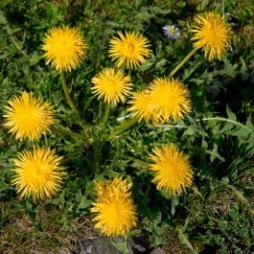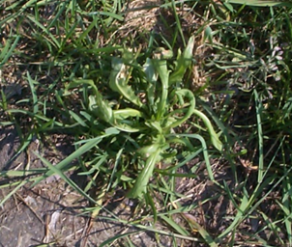Something that I expected, and we are already experiencing, is Dandelions blooming extremely early this season. This can be explained pretty easily, but what can be done about them is a bit more complex.
To fully understand why we are witnessing so many dandelions blooming so early this spring, it’s as simple as looking back at last fall’s weather conditions. In many places, last fall we experienced fairly warm weather compared to the last few we’ve had. On Christmas day, I was actually able to get pictures of some dandelions blooming, which was the first  time I’d ever seen this. I jokingly mentioned to my wife that we might actually receive some calls from customers wanting us to treat their lawns. Don’t get me wrong, I wasn’t complaining about the nice weather (it did extend the golf season), but I knew seeing all of those weeds so late in the year would spell some headaches this spring.
time I’d ever seen this. I jokingly mentioned to my wife that we might actually receive some calls from customers wanting us to treat their lawns. Don’t get me wrong, I wasn’t complaining about the nice weather (it did extend the golf season), but I knew seeing all of those weeds so late in the year would spell some headaches this spring.
Due to the warm fall weather last year, those pesky dandelions were able to germinate late in October and early November and grew pretty big, even blooming in late December as I mentioned above. Typically in the fall, dandelions will germinate and start growing prior to the winter season and will then enter a state of dormancy once the temperatures drop. Typically they are small in the spring and some will germinate once the soil warms up. They are usually the first weed that you notice on the lawn due to their yellow flower.
A lot of people, once they see dandelions flowering, want to get out there and treat them immediately. However, treating them when the nights are still cool and the soil temperatures are as well can mean slower results. I have seen early applications take more than a month for the weeds to die. Also, treating dandelions too early on can lead to having to treat the lawn a number of times rather than just once. Keep in mind, herbicides used to control broadleaved weeds do not prevent them from germinating, they only get rid of the weeds that are up and growing. So if you’re too early, you will miss a lot of those late-germinating plants such as plantain or knotweed (to name just a few), therefore resulting in having to re-treat your turf each time a new set of weeds germinates throughout the season. Those who wait to treat their lawn will experience better results, with less amount of time and product required, saving you some cost.
What if the dandelion flowers and turns to seed? Not to worry! It will anyways once the herbicide is applied; and regardless, if it does or doesn’t, there are thousands of seeds lying dormant in the soil already, so adding more really won’t make much of a difference. The best defense against weeds is a healthy, thick lawn that will help prevent those seeds from germinating. A lush and nutrient-filled turf will also keep them from getting the sunlight they require in order to germinate.
Questions about your lawn? Weed Man would be happy to help you. Find your local Weed Man using our locator map HERE.
Keep those lawns healthy,
Chris


